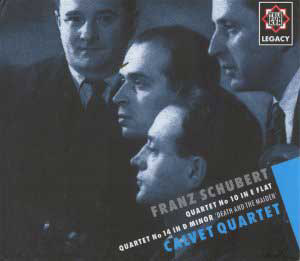Yehudi Menuhin as a boy once left perplexed during the middle
of a concert given by the then leading French Quartet, the venerable Capet.
He couldn’t take their bare minimum of vibrato and it took him years to
appreciate the artistry and the aesthetico-musical principles that lay
behind their playing. The Capet dominated Parisian quartet playing until
Lucien Capet, the first violinist and eminence grise died in 1928. Meanwhile
other well-trained, tonally exceptional quartets began to emerge from
the Conservatoires and hothouse encounters with such as Thibaud and Enescu,
who played informally with many of them. The Franco-Belgian Pro Arte were
perhaps the best known and recorded extensively but the Flonzaley were
active as well, mainly in America, where they were sponsored and financed.
Other quartets of stature included the Bouillon and the Krettly later
to be joined by the Pascal – León Pascal was the violist of the
Calvet – Champeil and Loewenguth. All recorded and all were distinguished
exponents of French or Franco-Belgian literature in particular although
their influence began to wane under the assault of the Soviet violin school.
Foremost among French quartets after the demise of
the Capet was the Calvet. The original line-up consisted of violinists
Joseph Calvet, Georges Mignot, León Pascal and cellist Paul Mas.
At the end of the 1920s second violinist Mignot resigned and was replaced
by Daniel Guilovitch, later famous for his eponymous Quartet in America
and leadership of Toscanini’s NBC Orchestra. He was perhaps most famous,
after a name change to Guilet, as the founder of the Beaux Arts Trio
in 1955 until his retirement in 1969. The thirties saw the first recordings
of the Calvet and a series of prestigious first performances – Delannoy,
Françaix, Guy-Ropartz, and Hahn (they recorded Delannoy, Caplet
and one movement of Florent Schmitt’s Piano Quintet). The Quartet was
to break up under the pressure of the War with Guilovitch’s escape to
America, reformed briefly but never regained its international place.
The Calvet has fared well on CD recently. A Japanese
set devoted to the French quartet tradition devotes three volumes to
them – SGR 8664-56. LYS has also been busy on their behalf – there are
at least four volumes, LYS298/99, 311, 323, 339 and this new Telefunken
Legacy issue of the Schubert Quartets replicates LYS311. The Quartet
had a superb pedigree. Calvet had studied under Rémy at the Paris
Conservatoire. Violist Pascal was a pupil of the greatest of French
viola players, Maurice Vieux. Guilovitch had enjoyed the cultured milieu
of the intimate chamber evenings hosted by Thibaud and others. There
is a refined, raffiné quality to their Schubert that is immediately
attractive, with exquisite tonal qualities of balance and weight and
a rather feminine impress. Attacks are moderate in scale, dynamics are
even, rubato subtle and pervasive, portamanti quick, expressive and
minimal. In the E Flat major quartet they find temperate gravitas and
tonal luxuriance, a marvelous sweetness that is never over familiar.
How adeptly they deploy the final resigned pizzicato at the close of
the work. Death and the Maiden again demonstrates qualities of
tonal blend, unanimity and sagacity of tempo relation and internal balancing.
It may seem rather smaller scale than contemporary performance has come
to expect but there can be no gainsaying the means by which the Calvet
convey the intimacy and drama of it and the sheer beauty of sound they
confer upon it. All the Telefunken legacy series that I’ve seen are
beautifully produced, in three languages – notes here by Tully Potter
- with evocative photographs housed in book form with 78-style record
sleeve complete with Telefunken motif. Strongly recommended.
Jonathan Woolf


